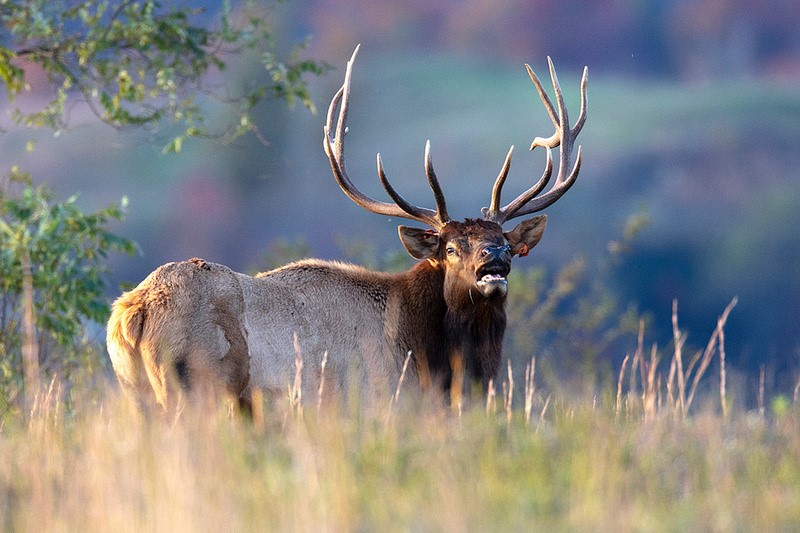COMMENTARY BY DAVE SAMUEL
Long before elk were recently introduced into West Virginia, officials knew some deaths could occur from a parasite gotten from deer. In Spring 2019, there were an estimated 85-95 elk in the wilds of the state. What no one predicted was this roundworm found in deer would lead to deaths and a fall population of 75-85. With so few elk, any loss is big, but the brain worm loss was very big.
Last week, a friend told me, “You have to write a column about this deer brain worm.” I quickly asked why. “Because hunters are spreading a rumor that the disease was introduced by the DNR to kill the elk.” Are you kidding me? Some hunters tend to spread really dumb rumors, and even dumber hunters believe them, but this one takes the cake. What possible reason could the DNR have for wanting to get rid of elk after spending thousands of dollars and thousands of work hours to get a herd started here? I have no clue, but let’s just end this rumor. The DNR had nothing to do with deer brain worm.
My friend indicated there was a second hunt-spread rumor that humans can get deer brain worm. How about a simple answer? No, they can’t.
There are several major concerns when a state considers reintroducing elk. The first concern is chronic wasting disease (CWD). Since CWD is now common in many western states, bringing in elk from the West is a slippery slope. Yes, it worked in Kentucky and it lucked out probably because it brought elk in before CWD got a foothold in many western states. A second concern is finding good habitat for the elk in areas where agriculture damage from the elk won’t be a big factor. Third, is the fact that deer have brain worm and it can spread to elk, but this hasn’t really impacted elk reintroductions in most states.
Deer brain worms are common in deer in the Northeast and to a lesser degree in the Midwest. These roundworm parasites are found in spaces and veins around the brain, and although elk can get them, moose are even more susceptible. Here’s how the elk get the disease. It’s a bit complicated, so follow closely.
The adult worms are in the veins and spaces in deer brains. Female’s lay eggs that develop into larvae that migrate through the bloodstream and lodge in the lungs. The deer then coughs them up and swallows them. The larvae pass through the stomach and intestine and out on the ground via feces. From the time a deer is infected, it is about three months before larvae appear in the feces. Then the larvae are eaten by snails (or slugs) and develop into larval stages 2 and 3, which deer get by accidentally eating the snail or slug while consuming grass.
Then the larvae penetrate the stomach or intestinal wall of the deer and migrate through the body cavity to the spinal cord and up to the brain. During this last migration, the larvae develops into the adult worm. Complicated with many steps, but it works for the parasite. Most deer that get the worm do so in the first or second year of its life.
The disease sounds nasty, but most deer show no signs of the disease. If they get a large infection by consuming many infected slugs or snails, they may show temporary lameness, or circling behavior, especially in fawns. When moose or elk eat the infected slugs, they lose coordination, commonly walk in tight circles with their head tilted, lose fear, sometime go blind, and finally die. Infected elk tend to leave the herd and become less wary. Circling is common and the tilted head position is, too. Once the elk eats the infected snails, it starts to show symptoms 10-60 days later.
We’ve seen elk increase in other states that have deer. In fact, the Pennsylvania herd has shown growth in recent years and some suggest this occurred because doe harvests increased, lowering deer numbers and thus lowering the potential for brain worm. Obviously, deer and elk can, and do coexist, but it is believed that the federally-mandated lengthy quarantine of our elk, caused the cows and calves to lose weight and thus, were not in the best of health when released. This probably exacerbated the elk getting deer brain worm.
In the meantime, most state wildlife agencies are giving more pause before bringing in elk from the West because of chronic wasting disease. While deer can live quite well with brain worm, they do not survive once they get CWD. End of game.
Hopefully, the remaining elk dodge this brain worm bullet, and our herd will expand, but chances for bringing in more western elk to add to what elk we have are not as high as in years past. Yes, when it comes to our wild deer, CWD is that scary. And that’s no rumor.
Dr. Samuel is a retired wildlife professor from West Virginia University. His outdoor columns have appeared, and continue to appear, in Bowhunter magazine and the Whitetail Journal. If you have questions or comments on wildlife and conservation issues, email him at drdave4@comcast.net.




